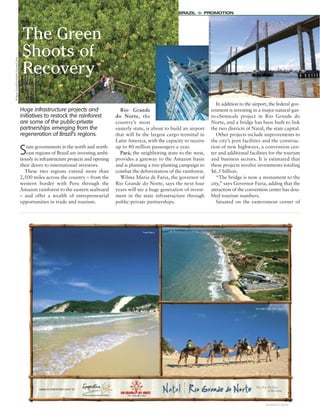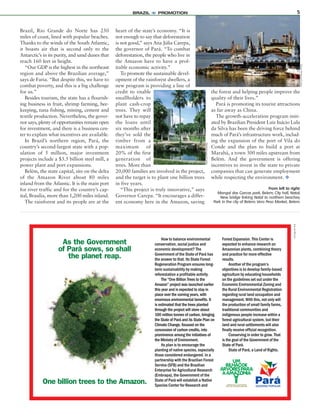Despite the global economic downturn, Brazil's economy has remained resilient, growing at an estimated rate of 2.5% in 2009. Domestic demand rather than exports has fueled Brazil's growth, led by its expanding middle class. The Brazilian government has taken measures to maintain consumer confidence, such as cutting personal taxes. Key industries like agriculture have continued to thrive, with the agriculture sector growing at an average annual rate of 5%. Going forward, Brazil is working to diversify its economy and further develop its infrastructure through public-private partnerships.








![9
Its name should be as recognizable as the
Amazon. It is larger than New Mexico
and is the world’s largest freshwater wet-
land, with an unparalleled variety of flora
and fauna. Yet beyond environmental
enthusiasts, the Pantanal is little known.
André Puccinelli, the governor of Mato
Grosso do Sul, the state in which 70% of
the Pantanal is located, intends to challenge
this ignorance. And, while publicizing the
attributes of his state’s ecological paradise,
he intends to more clearly establish the
identity of Mato Grosso do Sul, often con-
fused with its northern neighbor Mato
Grosso, from which the federal government
separated it in 1979.
“We are starting an international cam-
paign, distributing DVDs, pictures, books
and folders of information about our state
and the Pantanal through Brazilian
embassies around the world,” he says.
Governor
Puccinelli has
a reputation
for getting
things done. “When I took office in 2007,
the state had a monthly revenue of R$350
million [US$153 million] and a deficit of
R$30 million [US$12.9 million],” he says.
“Now we have a monthly revenue of
R$470 million [US$205.4 million] and a
surplus of R$40 million [US$17.5 mil-
lion].”
The state has completed some new infra-
structure projects and begun others, and has
increased and exceeded its house-building
targets, creating work for low-skilled
workers.
“We are now the fifth-largest producer
of ethanol in the country and by 2015 will
be the second largest,” says Puccinelli.
The state’s economy is based primarily on
livestock, grains and
forestry. The govern-
ment is now taking
measures to induce
investment projects
that will add greater
value to homegrown
resources.
“We produce
10 million tons of
grain, 5 million tons
of soybeans and
more than 3 million tons of corn,” says the
governor. Yet the state has only one indus-
try based on these products. It also has huge
reserves of minerals, but lacks investment
in exploration and processing.
“What we need is industrialization to
turn iron into final products, process
meat and initiate other projects,” says
Puccinelli. “For such projects the state may
give land free of cost.”
One of Mato Grosso do Sul’s biggest
attractions for investment is its land, which
it claims is more competitively priced than
land anywhere else in Brazil. “And we offer
exemption of up to 90% of taxes for ini-
tiatives that are lacking in the state,” says
the governor. O
Stake Your Claim
An ecological paradise that wants to encourage
investment in manufacturing offers free land and
tax incentives.
BRAZIL = PROMOTION
JacquesJangoux/Alamy](https://image.slidesharecdn.com/481a3bea-9f6a-4d2f-8de3-f223c5a1f340-160221192508/85/Brazil-1-Forbes-9-320.jpg)

![festivals, exhibitions and sporting contests.
At present, Brazil, which occupies almost
70% of the region, receives fewer than
30,000 tourist visitors annually to the two
states that extend into the Amazon basin,
Amazonas and Pará.
Indeed, in spite of Brazil’s obvious attrac-
tions – glorious beaches along 6,000 miles
of coastline, a fascinating indigenous and
colonial heritage, and a wealth of cultural
diversity – the full economic clout of the
international tourism sector has yet to
make a substantial impact on the country.
The annual number of tourists is lit-
tle more than five million, a third of whom
head for Rio de Janeiro, and fewer than a
million visitors are from the U.S.
Although the number of visitors is rela-
tively small, Jeanine Pires, president of
Embratur, the national tourism agency, says
that visitors stay longer, an average of 18
or 19 days, visit more cities and spend more
money. Its Aquarela tourism plan, intro-
duced in 2005, is designed to promote sun
and beach holidays, sports, ecotourism, cul-
ture and business tourism and events.
Furthermore, new airline routes to
American cities have been opened and
US$1 billion is being devoted to a tourism
development program with the aim of
enabling Brazil to compete to host two
major sporting events, the World Soccer
Cup competition and the summer Olympic
Games, both in 2014. O
11BRAZIL = PROMOTION
Seeds of Growth
Banco do Nordeste is currently pro-
viding 400,000 small-scale business
farmers with microcredit facilities and
aims to reach a million customers
with funding by 2011.
“We are the largest institution pro-
viding microcredit in South America,”
says Robert Smith, the bank president.
Although it is charged primarily
with promoting the sustainable devel-
opment of the northeast region, the
bank has extended its microcredit
facilities to the slums of Rio de Janeiro
at the request of President Lula da Silva.
Social responsibility and sustainable devel-
opment are key strategic factors in the
management of Brazil’s leading companies.
Grupo Orsa, the country’s largest inte-
grated paper and corrugated-cardboard-box
producer, has created a philanthropic foun-
dation through which it is planning major
projects to fight malaria and conserve the
forests in the Amazon Delta.
“In the last ten years, Orsa has invested
R$140 million [US$58.7m] in our founda-
tion’s activities,” says Sergio Antonio
Garcia Amoroso, the Orsa president. One
of the group’s actions, he says, has been to
create a company called Orsa Florestal that
will develop 845,000 hectares of managed
forest over a ten year period, while provid-
ing income and improving the health and
education of the forest dwellers.
“We are already directing a fairly exten-
sive program of promotion for Curua
eucalyptus, a long-grain Amazon plant
that can be used to replace plastic,” he says.
Another of Brazil’s flagship institutions,
Vale, the world’s second largest mining com-
pany, regards sustainable development as
its core duty and says it fulfills this by min-
ing and processing mineral resources in an
environmentally responsible manner.
Vale’s petrochemical production is
achieved by using technology whose emis-
sions are lower than the legal level, even
though this involves an extra cost of more
than $50 million, says Demian Fiocca, exec-
utive director for management and sustain-
ability.
Vale’s social responsibility extends beyond
its own mining operations. “We don’t
mine in China but we have some joint ven-
tures there and have been very engaged in
helping the recovery from the recent earth-
quake,” says Fiocca. “We have donated $1
million to the Red Cross and around
$400,000 to a non-government organiza-
tion that works with children in the affected
countryside.” O
ModaFusion, the brainchild of French
fashion journalist Nadine Gonzalez and
Brazilian designer Andrea Fasanello, is
attracting the attention of the interna-
tional fashion press. The Franco-Brazilian
association promotes ethical fashion and
showcases the creativity of women from
the Brazilian slums.
“We are working with French stylists
to transform the language of the favelas
into a fashion design language,” says
Gonzalez. “Every year a student from
French top fashion schools is chosen to
develop a collection for ModaFusion”
Carla Bruni, the wife of President
Sarkozy of France, is a patron and wears
ModaFusion clothes, while stylists who
have worked for the association have gone
on to work for luxury brands such as Jean
Paul Gauthier Couture and Celine.
ModaFusion’s 2009 summer collection
features dresses made of knitted fabrics
derived from bamboo fiber and others
created from recycled plastic.O
Fashion Forward
How companies with ethical
policies help communities and
protect the environment
Brazil’s Business Benefactors
These two pages were prepared specifically for this reprint and did not appear in Forbes magazine](https://image.slidesharecdn.com/481a3bea-9f6a-4d2f-8de3-f223c5a1f340-160221192508/85/Brazil-1-Forbes-11-320.jpg)
